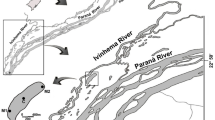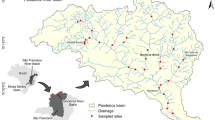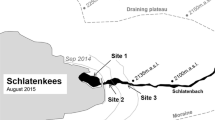Abstract
This study examined chironomid responses to the flooding of ten drained experimental marshes in Delta Marsh, Manitoba, Canada. Emergence traps were used to monitor chironomid emergence from three vegetation types (Symphyotrichum ciliatum, Scolochloa festucacea, and Schoenoplectus tabernaemontani) flooded at two water depths (shallow: 20–40 cm, deep: 50–70 cm) over a four-year period. The greatest number (7,651 m−2 yr−1) and biomass (20.3 g m−2 yr−1) of chironomids emerged from Schoenoplectus-deep sites in the fourth year of flooding. Numbers, biomass, and size classes of emerging chironomids were similar over the four years from the Symphyotrichum habitat. However, chironomid emergence from Scolochloa and Schoenoplectus habitats was dominated initially by the smallest size class but shifted steadily toward production of much larger species over the four-year experiment. The production of chironomids as a potential food resource for waterfowl was high from the Symphyotrichum habitat during all four years of flooding, but emergence from the Scolochloa and Schoenoplectus habitats did not reach comparable levels until the third or fourth year.
Similar content being viewed by others
Literature Cited
Anderson, J. T. and L. M. Smith. 2000. Invertebrate response to moist-soil management of playa wetlands. Ecological Applications 10:550–558.
Ball, J. P. and T. D. Nudds. 1989. Mallard habitat selection: an experiment and implications for management. p. 659–671. In R. R. Sharitz and J. W. Gibbons (eds.). Freshwater Wetlands and Wildlife. USDOE Office of Scientific and Technical Information, Charleston, SC, USA. CONF-8603101, DOE Symposium Series No. 61.
Batzer, D. P., F. de Szalay, and V. H. Resh. 1997. Opportunistic response of a benthic midge (Diptera: Chironomidae) to management of California seasonal wetlands. Environmental Entomology 26:215–222.
Batzer, D. P., M. McGee, V. H. Resh, and R. R. Smith. 1993. Characteristics of invertebrates consumed by mallards and prey responses to wetland flooding schedules. Wetlands 13:41–49.
Batzer, D. P. and V. H. Resh. 1992. Macroinvertebrates of a California seasonal wetland and responses to experimental habitat manipulation. Wetlands 12:1–7.
Beehler, J. W. and M. S. Mulla. 1993. The effect of organic enrichment and flooding duration on the oviposition behavior of Culex mosquitoes. Proceedings of the California Mosquito and Vector Control Association 61:121–124.
Cox, Jr., R., M. A. Hanson, C. C. Roy, N. H. Euliss, Jr., D. H. Johnson, and M. G. Butler. 1998. Mallard duckling growth and survival in relation to aquatic invertebrates. Journal of Wildlife Management 62:124–133.
Danell, K. and K. Sjöberg. 1982. Successional patterns of plants, invertebrates and ducks in a man-made lake. Journal of Applied Ecology 19:395–409.
Davis, C. B. and A. G. van der Valk. 1978. Mineral release from the litter of Bidens cernua L., a mudflat annual at Eagle Lake, Iowa. Verhandlungen Internationale Vereinigung für Theoretische und Angewandte Limnologie 20:452–457.
de Swart, E. O. A. M., A. G. van der Valk, K. J. Koehler, and A. Barendregt. 1994. Experimental evaluation of realized niche models for predicting responses of plant species to a change in environmental conditions. Journal of Vegetation Science 5:541–552.
de Szalay, F. A., D. P. Batzer, and V. H. Resh. 1996. Mesocosm and macrocosm experiments to examine effects of mowing emergent vegetation on wetland invertebrates. Environmental Entomology 25:303–309.
de Szalay, F. A. and W. Cassidy. 2001. Effects of muskrat (Ondatra zibethicus) lodge construction on invertebrate communities in a Great Lakes coastal wetland. American Midland Naturalist 146: 300–310.
de Szalay, F. A., N. H. Euliss, Jr., and D. P. Batzer. 1999. Seasonal and semipermanent wetlands of California. Invertebrate community ecology and responses to management methods. p. 829–855. In D. P. Batzer, R. B. Rader, and S. A. Wissinger (eds.) Invertebrates in Freshwater Wetlands of North America: Ecology and Management. John Wiley & Sons, Inc., New York, NY, USA.
de Szalay, F. A. and V. H. Resh. 1997. Responses of wetland invertebrates and plants important in waterfowl diets to burning and mowing of emergent vegetation. Wetlands 17:149–156.
de Szalay, F. A. and V. H. Resh. 2000. Factors influencing macro-invertebrate colonization of seasonal wetlands: responses to emergent plant cover. Freshwater Biology 45:295–308.
Driver, E. A.. 1977. Chironomid communities in small prairie ponds: some characteristics and controls. Freshwater Biology 7:121–133.
Euliss, Jr., N. H. and G. Grodhaus. 1987. Management of midges and other invertebrates for waterfowl wintering in California. California Fish and Game 73:238–243.
Gray, M. J., R. M. Kaminski, G. Geerakkody, B. D. Leopold, and K. C. Jensen. 1999. Aquatic invertebrate and plant responses following mechanical manipulations of moist-soil habitat. Wildlife Society Bulletin 27:770–779.
Grimshaw, H. J., R. G. Wetzel, M. Brandenburg, K. Segerblom, L. J. Wenkert, G. A. Marsh, W. Charnetzky, J. E. Haky, and C. Carraher. 1977. Shading of periphyton communities by wetland emergent macrophytes: decoupling of algal photosynthesis from microbial nutrient retention. Archiv für Hydrobiologie 139:17–27.
Harris, S. W. and W. H. Marshall. 1963. Ecology of water-level manipulations on a northern marsh. Ecology 44:331–343.
Kadlec, J. A. 1986a. Effects of flooding on dissolved and suspended nutrients in small diked marshes. Canadian Journal of Fisheries and Aquatic Sciences 43:1999–2008.
Kadlec, J. A. 1986b. Input—output nutrient budgets for small diked marshes. Canadian Journal of Fisheries and Aquatic Sciences 43: 2009–2016.
Kadlec, J. A. 1989. Effects of deep flooding and drawdown on freshwater marsh sediments. p. 127–143. In R. R. Sharitz and J. W. Gibbons (eds.) Freshwater Wetlands and Wildlife. USDOE Office of Scientific and Technical Information, Oak Ridge, TN, USA.
Kadlec, J. A. and L. M. Smith. 1992. Habitat management for breeding areas. p. 590–610. In B. D. J. Batt, A. D. Afton, M. G. Anderson, C. D. Ankney, D. H. Johnson, J. A. Kadlec, and G. L. Krapu (eds.) Ecology and Management of Breeding Waterfowl. University of Minnesota Press, Minneapolis, MN, USA.
Kaminski, R. M. and H. H. Prince. 1981. Dabbling duck and aquatic macroinvertebrate responses to manipulated wetland habitats. Journal of Wildlife Management 45:1–15.
Keiper, J. B., J. A. Jiannino, M. R. Sanford, and W. E. Walton. 2002. Effect of vegetation management on the abundance of mosquitoes at a constructed treatment wetland in southern California. Proceedings of the California Mosquito and Vector Control Association 70:35–43.
Kenow, K. P. and D. H. Rusch. 1989. An evaluation of plant and invertebrate response to water level manipulation on subimpoundments of Horicon Marsh, Wisconsin. p. 1153–1163. In R. R. Sharitz and J. W. Gibbons (eds.) Freshwater Wetlands and Wildlife. USDOE Office of Scientific and Technical Information, Oak Ridge, TN, USA.
Kesler, D. H.. 1981. Grazing rate determination of Corynoneura scutellata Winnertz (Chironomidae: Diptera). Hydrobilogia 80:63–66.
King, R. S. and D. A. Wrubleski. 1998. Spatial and diel availability of flying insects as potential duckling food in prairie wetlands. Wetlands 18:100–114.
Krapu, G. L. and K. J. Reinecke. 1992. Foraging ecology and nutrition. p. 1–29. In B. D. J. Batt, A. D. Afton, M. G. Anderson, C. D. Ankney, D. H. Johnson, J. A. Kadlec, and G. L. Krapu (eds.) Ecology and Management of Breeding Waterfowl. University of Minnesota Press, Minneapolis, MN, USA.
LeSage, L. and A. D. Harrison. 1979. Improved traps and techniques for the study of emerging aquatic insects. Entomological News 90:65–78.
McKnight, D. E. and J. B. Low. 1969. Factors affecting waterfowl production on a spring-fed salt marsh in Utah. Transactions of the North American Wildlife and Natural Resources Conference 34: 307–314.
Murkin, H. R. and B. D. J. Batt. 1987. The interactions of vertebrates and invertebrates in peatlands and marshes. p. 15–30. In D. M. Rosenberg and H. V. Danks (eds.) Aquatic Insects of Peatlands and Marshes in Canada. Memoirs of the Entomological Society of Canada 140.
Murkin, H. R., B. D. J. Batt, P. J. Caldwell, J. A. Kadlec, and A. G. van der Valk. 2000b. Introduction to the Marsh Ecology Research Program. p. 3–15. In H. R. Murkin, A. G. van der Valk, and W. R. Clark (eds.) Prairie Wetland Ecology. The Contribution of the Marsh Ecology Research Program. Iowa State University Press, Ames, IA, USA.
Murkin, H. R. and J. A. Kadlec. 1986. Responses by benthic macroin vertebrates to prolonged flooding of marsh habitat. Canadian Journal of Zoology 64:65–72.
Murkin, H. R., J. A. Kadlec, and E. J. Murkin. 1991. Effects of prolonged flooding on nektonic invertebrates in small diked marshes. Canadian Journal of Fisheries and Aquatic Sciences 48: 2355–2364.
Murkin, H. R., R. M. Kaminski, and R. D. Titman. 1982. Responses by dabbling ducks and aquatic invertebrates to an experimentally manipulated cattail marsh. Canadian Journal of Zoology 60:2424–2332.
Murkin, E. J., H. R. Murkin, and R. D. Titman. 1992. Nektonic invertebrate abundance and distribution at the emergent vegetation-open water interface in the Delta Marsh, Manitoba, Canada. Wetlands 12:45–52.
Murkin, H. R. and L. C. M. Ross. 1999. Macroinvertebrate responses to a simulated wet/dry cycle. p. 543–569. In D. P. Batzer, R. B. Rader, and S. A. Wissinger (eds.) Invertebrates in Freshwater Wetlands of North America: Ecology and Management. John Wiley & Sons, Inc., New York, NY, USA.
Murkin, H. R. and L. C. M. Ross. 2000. Invertebrates in prairie wetlands. p. 201–247. In H. R. Murkin, A. G. van der Valk, and W. R. Clark (eds.) Prairie Wetland Ecology. The Contribution of the Marsh Ecology Research Program. Iowa State University Press, Ames, IA, USA.
Murkin, H. R., A. G. van der Valk, W. R. Clark, L. G. Goldsborough, D. A. Wrubleski, and J. A. Kadlec. 2000a. Marsh Ecology Research Program: management implications for prairie wetlands. p. 317–344. In H. R. Murkin, A. G. van der Valk, and W. R. Clark (eds.) Prairie Wetland Ecology. The Contribution of the Marsh Ecology Research Program. Iowa State University Press, Ames, IA, USA.
Nudds, T. D. and J. N. Bowlby. 1984. Predator-prey size relationships in North American dabbling ducks. Canadian Journal of Zoology 62:2002–2008.
Rose, C. and W. G. Crumpton. 1996. Effects of emergent macrophytes on dissolved oxygen dynamics in a prairie pothole wetland. Wetlands 16:495–502.
SAS Institute Inc. 1999. SAS OnlineDoc®, Version 8. Cary, NC, USA.
Sedinger, J. S. 1992. Ecology of prefledging waterfowl. p. 109–127. In B. D. J. Batt, A. D. Afton, M. G. Anderson, C. D. Ankney, D. H. Johnson, J. A. Kadlec, and G. L. Krapu (eds.) Ecology and Management of Breeding Waterfowl. University of Minnesota Press, Minneapolis, MN, USA.
Shobanov, N. A., I. I. Kiknadze, and M. G. Butler. 1999. Palearctic and nearctic Chironomus (Camptochironomus) tentans (Fabricius) are different species (Diptera: Chironomidae). Entomologica Scandinavica 30:311–322.
Sjöberg, K. and K. Danell. 1982. Feeding activity of ducks in relation to diel emergence of chironomids. Canadian Journal of Zoology 60:1383–1387.
Squires, L. and A. G. van der Valk. 1992. Water-depth tolerances of emergent macrophytes of the Delta Marsh, Manitoba. Canadian Journal of Botany 70:1860–1867.
Street, M. and G. Titmus. 1979. The colonisation of experimental ponds by Chironomidae (Diptera). Aquatic Insects 1:233–244.
Sugden, L. G. 1973. Feeding ecology of pintail, gadwall, American widgeon and lesser scaup ducklings in southern Alberta. Canadian Wildlife Service Report Series No. 24.
Suthers, I. M. and J. H. Gee. 1986. Role of hypoxia in limiting diel spring and summer distribution of juvenile yellow perch (Perca flavenscens) in a prairie marsh. Canadian Journal of Fisheries and Aquatic Science 43:1562–1570.
Swanson, G. A. 1977. Diel food selection by Anatinae on a wastestabilization system. Journal of Wildlife Management 41:226–231.
Swanson, G. A. and A. B. Sargeant. 1972. Observation of nighttime feeding behavior of ducks. Journal of Wildlife Management 36: 959–961.
Talent, L. G., G. L. Krapu, and R. L. Jarvis. 1982. Habitat use by mallard broods in south central North Dakota. Journal of Wildlife Management 46:629–635.
van der Valk, A. G. 1982. Succession in wetlands: a Gleasonian approach. Ecology 62:688–696.
van der Valk, A. G. 1982. Succession in temperate North American wetlands. p. 169–179. In B. Gopal, R. E. Turner, R. G. Wetzel, and D. F. Whigham (eds.) Wetlands: Ecology and Management. National Institute of Ecology, Jaipur, India.
van der Valk, A. G. 1987. Vegetation dynamics of freshwater wetlands: a selective review of the literature. Archiv für Hydrobiologie Ergenbnisse der Limnologie 27:27–39.
van der Valk, A. G. 1994. Effects of prolonged flooding on the distribution and biomass of emergent species along a freshwater wetland coenocline. Vegetatio 110:185–196.
van der Valk, A. G. 2000. Vegetation dynamics and models. p. 125–161. In H. R. Murkin, A. G. van der Valk, and W. R. Clark (eds.) Prairie Wetland Ecology. The Contribution of the Marsh Ecology Research Program. Iowa State University Press, Ames, IA, USA.
van der Valk, A. G. and C. B. Davis. 1976. The seed banks of prairie clacial marshes. Canadian Journal of Botany 54:1832–1838.
van der Valk, A. G. and C. B. Davis. 1978. The role of seed banks in the vegetation dynamics of prairie glacial marshes. Ecology 59:322–335.
van der Valk, A. G., H. R. Murkin, and J.A. Kadlec. 2000. The drawdown and reflooding years. p. 75–97. In H. R. Murkin, A. G. van der Valk, and W. R. Clark (eds.) Prairie Wetland Ecology. The Contribution of the Marsh Ecology Research Program. Iowa State University Press, Ames, IA, USA.
van der Valk, A. G., L. Squires, and C. H. Welling. 1994. Assessing the impact of an increase in water level on wetland vegetation. Ecological Applications 4:525–534.
van der Valm, A. G. and C. H. Welling. 1988. The development of zonation in freshwater wetlands. p. 145–158 In H. J. During, M. J. A. Werger, and J. H. Willems (eds.) Diversity and Pattern in Plant Communities. SPB Academic Publishing, The Hague, The Netherlands.
van der Valk, A. G., C. H. Welling, and R. L. Pederson. 1989. Vegetation change in a freshwater wetland: a test of a priori predictions. p. 207–217. In R. R. Sharitz and J. W. Gibbons (eds.) Freshwater Wetlands and Wildlife. USDOE Office of Scientific and Technical Information, Oak Ridge, TN, USA.
Voigts, D. K.. 1976. Aquatic invertebrate abundance in relation to changing marsh vegetation. American Midland Naturalist 95:313–322.
Walton, W. E., N. S. Tietze, and M. S. Mulla. 1990. Ecology of Culex tarsalis (Diptera: Culicidae): factors influencing larval abundance in mesocosms in southern California. Journal of Medical Entomology 27:57–67.
Weller, M. W.. 1978. Management of freshwater marshes for wildlife. p. 267–284. In R. E. Good, D. F. Whigham, and R. L. Simpson (eds.) Freshwater Wetlands. Ecological Processes and Management Potential. Academic Press, New York, NY, USA.
Weller, M. W. and L. H. Fredrickson. 1974. Avian ecology of a managed glacial marsh. Living Bird 12:269–291.
Welling, C. H., R. L. Pederson, and A. G. van der Valk. 1988a. Recruitment from the seed bank and the development of zonation of emergent vegetation during a drawdown in a prairie wetland. Journal of Ecology 76:483–496.
Welling, C. H., R. L. Pederson, and A. G. van der Valk. 1988b. Temporal patterns in recruitment from the seed bank during drawdowns in a prairie wetland. Journal of Applied Ecology 25:999–1007.
Whitman, W. R.. 1974. The response of macro-invertebrates to experimental marsh management. Ph. D. Dissertation, University of Maine, Orono, ME, USA.
Wrubleski, D. A. 1987. Chironomidae (Diptera) of peatlands and marshes in Canada. p. 141–161. In D. M. Rosenberg and H. V. Danks (eds.) Aquatic insects of peatlands and marshes in Canada. Memories of the Entomological Society Canada 140.
Wrubleski, D. A.. 1991. Chironomidae (Diptera) community development following experimental manipulation of water levels and aquatic vegetation. Ph. D. Dissertation. University of Alberta, Edmonton, AB, Canada.
Wrubleski, D. A.. 1999. Northern prairie marshes (Delta Marsh, Manitoba). II. Chironomidae (Diptera) responses to changing plant communities in newly flooded habitats. p. 571–601. In D. P. Batzer, R. B. Rader, and S. A. Wissinger (eds.) Invertebrates in Freshwater Wetlands of North America: Ecology and Management. John Wiley & Sons, Inc., New York, NY, USA.
Wrubleski, D. A. and D. M. Rosenberg. 1990. The Chironomidae (Diptera) of Bone Pile Pond, Delta Marsh, Manitoba, Canada. Wetlands 10:243–275.
Author information
Authors and Affiliations
Corresponding author
Rights and permissions
About this article
Cite this article
Wrubleski, D.A. Chironomidae (diptera) responses to the experimental flooding of prairie marshes. Wetlands 25, 200–209 (2005). https://doi.org/10.1672/0277-5212(2005)025[0200:CDRTTE]2.0.CO;2
Received:
Revised:
Accepted:
Issue Date:
DOI: https://doi.org/10.1672/0277-5212(2005)025[0200:CDRTTE]2.0.CO;2




